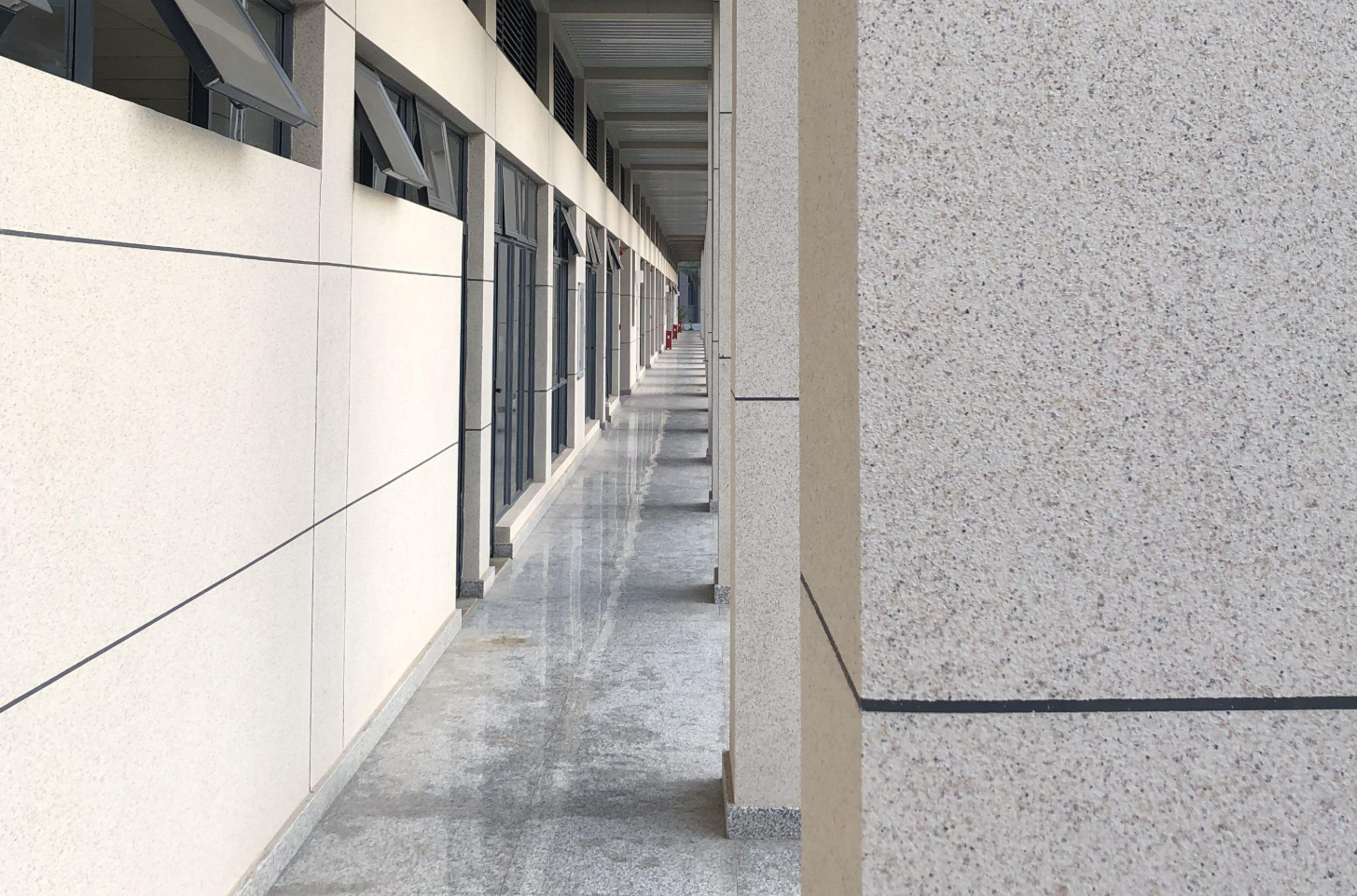Detailed Construction Technology and Precautions for Building Exterior Stone Paint
The construction process of building exterior stone paint includes several key steps: preparing materials and tools, treating the base layer, applying primer, marking and protecting grout lines, spraying stone paint, removing masking tape, sanding, applying topcoat, and final cleaning. Each step requires careful attention to detail, proper environmental conditions, and adherence to specific techniques to ensure a smooth, durable, and aesthetically pleasing finish. Proper preparation and execution are crucial for successful stone paint application.

I. Preparations Before Construction
- Material Preparation
- Stone Paint: Select a stone paint product that meets the standards, ensuring that the color and texture match the design requirements.
- Primer: An alkali-resistant primer is used to seal the base layer and prevent alkali from seeping out.
- Topcoat: A transparent or semi-transparent protective paint to enhance the weather resistance and water resistance of the stone paint.
- Putty: Special exterior putty for leveling the base layer.
- Auxiliary Materials: Masking tape, sandpaper, rollers, spray guns, etc.
- Tool Preparation
- Spray Gun: Used for spraying stone paint, select the appropriate nozzle size according to the requirements.
- Roller: Used for rolling primer and topcoat.
- Sandpaper: Used for sanding the putty layer and the stone paint surface.
- Masking Tape: For protecting the grout lines.
- Mixing Device: For mixing stone paint and putty.
- Other Tools: Putty knives, scrapers, brushes, etc.
- Inspection of the Base Layer
- Inspect whether the wall surface is flat, solid, and free from hollow drums, cracks, or powdery surfaces.
- Check the moisture content of the wall to ensure it is below 10%, and the pH value is below 10.
- Inspect the corners and lines of the base layer to ensure they are smooth and square.
II. Construction Technology Process
- Base Layer Treatment
- Clean the Base Layer: Remove dust, loose particles, oil, formwork release agents, and other impurities from the wall to ensure a clean surface.
- Repair the Base Layer: Repair cracks and holes on the wall using a dedicated repair material to fill in the gaps.
- Sand the Base Layer: Use sandpaper to sand the wall surface to achieve a smooth finish, with square corners and straight lines.
- Inspect the Base Layer: Ensure the wall surface is flat with deviations not exceeding 2 mm, and the corners are square.
- Application of Moisture-Resistant Putty
- Mix the Putty: Mix the exterior putty according to the product instructions to achieve a uniform consistency.
- Apply the Putty: Use a putty knife to apply the putty evenly on the wall surface, controlling the thickness to within 0.8 mm.
- Sand the Putty: After the putty dries, sand it smooth and remove any loose dust.
- Rolling on the Alkali-Resistant Primer
- Dilute the Primer: Dilute the primer according to the product requirements and mix well.
- Roll on the Primer: Use a roller to apply the primer evenly on the wall surface, ensuring there are no missed areas or runs.
- Drying Time: The drying time for the primer is generally 2–4 hours, depending on weather conditions.
- Grout Line Marking and Protection
- Mark the Lines: Use a chalk line to mark the positions of the grout lines according to the design requirements, ensuring they are straight horizontally and vertically.
- Apply Masking Tape: Apply masking tape along the marked lines to protect the grout lines. Ensure the tape is firmly attached with no gaps.
- Inspect the Tape: Ensure the masking tape is securely attached with no edges lifting.
- Spraying the Stone Paint
- Mix the Stone Paint: Stir the stone paint thoroughly to ensure there are no sediments.
- Test Spray: Conduct a test spray in an inconspicuous area to adjust the spray gun pressure and nozzle size to achieve the desired effect.
- Formal Spraying: Spray the stone paint in a top-to-bottom and left-to-right sequence, maintaining a distance of 30–50 cm between the spray gun and the wall, with a uniform movement speed.
- Spraying Thickness: The thickness of the stone paint is generally 2–3 mm, applied in two coats with an interval of 4–8 hours.
- Precautions: Avoid construction in high temperatures, strong winds, or rainy weather to prevent runs or too rapid drying of the stone paint.
- Removing Masking Tape and Grout Line Treatment
- Remove the Tape: Remove the masking tape when the stone paint is semi-dry (in a finger-press semi-dry state) to avoid damaging the stone paint.
- Clean the Grout Lines: After removing the tape, use a brush to clean any residual stone paint from the grout lines to ensure they are clear and neat.
- Sanding the Stone Paint
- Sanding Time: Sand the stone paint surface after it has fully dried (usually 24 hours) using 400–600 grit sandpaper to remove loose particles and sharp edges for a smooth finish.
- Sanding Method: Gently sand the surface of the stone paint with 400–600 grit sandpaper to remove loose particles and sharp edges, achieving a smooth finish.
- Precautions: Sand evenly to avoid damaging the stone paint coating.
- Rolling on the Topcoat
- Dilute the Topcoat: Dilute the topcoat according to the product requirements and mix well.
- Roll on the Topcoat: Use a roller to apply the topcoat evenly on the stone paint surface, ensuring there are no missed areas or runs.
- Drying Time: The drying time for the topcoat is generally 24 hours, depending on weather conditions.
- Cleaning and Inspection
- Clean the Site: After construction, clean the construction site, dismantle the scaffolding, and clean the tools.
- Inspection Criteria: Ensure the stone paint surface is flat, with consistent color, no runs, no missed areas, and clear, neat grout lines.
Construction Process Table
| Construction Step | Operation Content | Precautions |
|---|---|---|
| Base Layer Treatment | Clean the wall surface of impurities, repair cracks and holes, sand smooth, and check moisture content and pH value. | Ensure the wall is clean and flat, with moisture content <10% and pH value <10. |
| Application of Moisture-Resistant Putty | Mix exterior putty, apply evenly, and sand smooth. | Control putty thickness to within 0.8 mm, sand to remove loose dust. |
| Rolling on Alkali-Resistant Primer | Dilute primer, roll on evenly to ensure no missed areas. | Primer drying time is 2–4 hours; avoid construction in high temperatures or humid weather. |
| Grout Line Marking and Protection | Mark lines for positioning, apply masking tape for protection. | Ensure masking tape is firmly attached with no gaps; remove tape carefully to avoid damaging stone paint. |
| Spraying Stone Paint | Mix stone paint, test spray to adjust, and spray formally in two coats. | Spraying thickness is 2–3 mm; maintain a distance of 30–50 cm between spray gun and wall; avoid construction in high temperatures, strong winds, or rainy weather. |
| Removing Masking Tape and Grout Line Treatment | Remove masking tape when stone paint is semi-dry, clean grout lines. | Remove tape at the right time to avoid damaging stone paint. |
| Sanding Stone Paint | Sand the stone paint surface with 400–600 grit sandpaper to remove loose particles and sharp edges. | Sand evenly to avoid damaging the coating. |
| Rolling on Topcoat | Dilute topcoat, roll on evenly to ensure no missed areas. | Topcoat drying time is 24 hours; avoid construction in high temperatures or humid weather. |
| Cleaning and Inspection | Clean the construction site, dismantle scaffolding, and inspect the stone paint construction effect. | Ensure the stone paint surface is flat, with consistent color and clear grout lines. |
